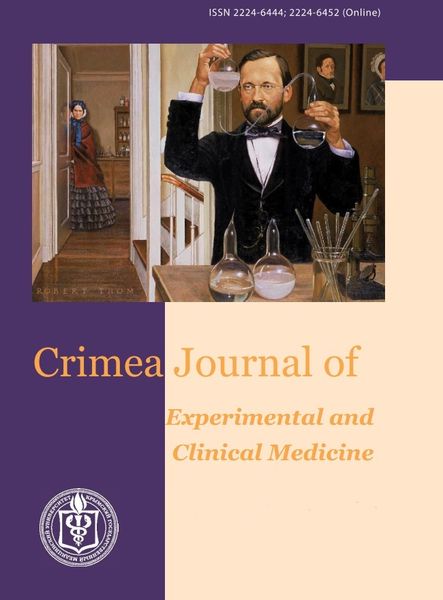Russian Federation
Saharnyy diabet(SD)yavlyaetsya nezavisimym faktorom povyshayuschim risk vozniknoveniya i neblagopriyatnogo techeniya razlichnyh zlokachestvennyh opuholey. Rol' MMP-9 v fiziologicheskih i patologicheskih processah, svyazannyh s remodelirovaniem i degradaciey kletochnogo matriksa shiroka i ne odnoznachna. Kortizol yavlyaetsya odnim iz priznannyh markerov stressa, vyzyvayuschih obshirnye fiziologicheskie reakcii. Samcy i samki belyh nelineynyh krys byli razdeleny na gruppy: intaktnye, inducirovannyy SD, karcinoma Gerena, karcinoma Gerena na fone SD. Pri SD v samostoyatel'nom i sochetannom variantah u samok krys uroven' MMR-9 v serdce byl nizhe, chem u intaktnyh zhivotnyh v 5,0 i 1,5 raza (r<0,05), a u samcov, naprotiv, vyshe v 1,4 raza i 1,7 raza (r<0,05). V pochkah samok uroven' MMR-9 pri SD v samostoyatel'nom variante i sochetannom byl nizhe, chem u intaktnyh zhivotnyh v 8,5 raza i 1,8 raza (r<0,05), togda kak u samcov byl nizhe tol'ko u zhivotnyh s samostoyatel'nym rostom karcinomy Gerena v 1,4 raza (r<0,05). Soderzhanie kortizola v serdce i pochkah u samcov i u samok issleduemyh grupp prevyshalo pokazateli intaktnyh zhivotnyh (u samok v gruppe s SD i SD + karcinoma Gerena v 1,5 raza (r<0,05) i 3,1 raza v serdce i v 2,6 raza i 3,1 raza v pochkah; u samcov v 1,5 raza i 1,4 raza (r<0,05) v serdce i v 1,5 raza i 1,7 raza (r<0,05) v pochkah). Polovye razlichiya v soderzhanii MMR-9 pri issledovannyh patologiyah mogut svidetel'stvovat' o raznyh mehanizmah razvitiya diabeticheskih oslozhneniy v tkani serdca i pochek.
diabetes mellitus, Guerin’s carcinoma, kidneys, heart, MMP-9, cortisol, rats
1. Harding J.L., Andes L.J., Gregg E.W., Cheng Y.J., Weir H.K., Bullard K.M., Burrows N.R., Imperatore G. Trends in cancer mortality among people with vs. without diabetes in the USA, 1988-2015. Diabetologia. 2020;63:75-84. doi:https://doi.org/10.1007/s00125-019-04991-x.
2. Peeters S.A., Engelen L., Buijs J., Chaturvedi N., Fuller J.H., Jorsal A., Parving H.H., Tarnow L., Theilade S., Rossing P., et al. Circulating matrix metalloproteinases are associated with arterial stiffness in patients with type 1 diabetes: Pooled analysis of three cohort studies. Cardiovasc. Diabetol. 2017;16:139. doi:https://doi.org/10.1186/s12933- 017-0620-9.
3. Birkeland K.I., Bodegard J., Eriksson J.W., Norhammar A., Haller H., Linssen G.C.M, Banerjee A., Thuresson M., Okami S., Garal-Pantaler E., Overbeek J., Mamza J.B., Zhang R., Yajima T., Komuro I., Kadowaki T. Heart failure and chronic kidney disease manifestation and mortality risk associations in type 2 diabetes: A large multinational cohort study. .Diabetes Obes Metab. 2020;22(9):1607-1618. doi:https://doi.org/10.1111/dom.14074.
4. Cui N., Hu M., Khalil R.A. Biochemical and biological attributes of matrix metalloproteinases. Prog. Mol. Biol. Transl. Sci. 2017;147:1-73. doi: 10.1016/ bs.pmbts.2017.02.005.
5. Kapoor C., Vaidya S., Wadhwan V., Kaur G., Pathak A. Seesaw of matrix metalloproteinases (MMPs) J. Cancer Res. Ther. 2016;12:28-35. doi:https://doi.org/10.4103/0973- 1482.157337.
6. Watson C., Spiers J.P., Waterstone M., Russell- Hallinan A., Gallagher J., McDonald K., Ryan C., Gilmer J., Ledwidge, M. (2021). Investigation of association of genetic variant rs3918242 of matrix metalloproteinase-9 with hypertension, myocardial infarction and progression of ventricular dysfunction in Irish Caucasian patients with diabetes: a report from the STOP-HF follow-up programme. BMC cardiovascular disorders. 2021;21(1):87. doi:https://doi.org/10.1186/s12872-021-01860-7.
7. Uemura S., Matsushita H., Li W., Glassford A.J., Asagami T., Lee K.H., Harrison D.G., Tsao P.S. Diabetes mellitus enhances vascular matrix metalloproteinase activity: Role of oxidative stress. Circ. Res. 2001;88:1291- 1298. doi:https://doi.org/10.1161/hh1201.092042.
8. Garcia-Fernandez N., Jacobs-Cacha C., Mora- Gutierrez J.M., Vergara A., Orbe J., Soler M.J. Matrix Metalloproteinases in Diabetic Kidney Disease. J. Clin. Med. 2020;9:472. doi:https://doi.org/10.3390/jcm9020472.
9. Kwok M.K., Kawachi I., Rehkopf D., Schooling C.M. The role of cortisol in ischemic heart disease, ischemic stroke, type 2 diabetes, and cardiovascular disease risk factors: a bi-directional Mendelian randomization study. BMC Med. 2020;18(1):363. doi: https://doi.org/10.1186/s12916-020- 01831-3.
10. Wolf P., Winhofer Y., Krššbk M., Krebs M. Heart, lipids and hormones. Endocr Connect 2017;6:R59-69. doi: https://doi.org/10.1530/EC-17-0031.
11. Kit O.I., Franciyanc E.M., Kaplieva I.V., Trepitaki L.K., Evstratova O.F. Sposob polucheniya metastazov pecheni v eksperimente. Byulleten' eksperimental'noy biologii i mediciny. 2014;157(6):745-747.
12. Zhukova G.V., Shihlyarova A.I., Sagakyanc A.B., Protasova T.P. O rasshirenii variantov ispol'zovaniya myshey BALB/cnude dlya eksperimental'nogo izucheniya zlokachestvennyh opuholey cheloveka in vivo. Yuzhno-rossiyskiy onkologicheskiy zhurnal. 2020;1(2):28-35. doi: org/10.37748/2687-0533-2020-1-2-4.
13. International Diabetes Federation. IDF Diabetes Atlas 9th Edition 2019 Available from: https://www. diabetesatlas.org/en/. Accessed 30 Jan 2020.
14. Schiebinger L., Klinge I., Sbnchez de Madariaga I., Paik H.Y., Schraudner M., Stefanick M. Gendered innovations in science, health, medicine, engineering and environment. Available at genderedinnovations. stanford. edu/what-is-gendered-innovations. html. Accessed January 2011;21:2015.
15. Harreiter J., Fadl H., Kautzky-Willer A., Simmons D. Do Women with Diabetes Need More Intensive Action for Cardiovascular Reduction than Men with Diabetes? Current diabetes reports. 2020;20(11):61. https://doi. org/10.1007/s11892-020-01348-2.
16. Euler G., Locquet F., Kociszewska J., Osygus Y., Heger J., Schreckenberg R., Schl'ter K. D., Kenyeres Y., Szabados T., Bencsik P., Ferdinandy P., Schulz R. Matrix Metalloproteinases Repress Hypertrophic Growth in Cardiac Myocytes. Cardiovascular drugs and therapy.2021;35(2):353-365. https://doi.org/10.1007/ s10557-020-07138-y.
17. Clemens K.K., Woodward M., Neal B., Zinman B. Sex Disparities in cardiovascular outcome trials of populations with diabetes: a systematic review and meta- analysis. Diabetes Care. 2020;43(5):1157-1163.
18. Kautzky-Willer A., Harreiter J., Pacini G. Sex and Gender Differences in Risk, Pathophysiology and Complications of Type 2 Diabetes Mellitus. Endocrine reviews.2016;37(3):278-316. https://doi.org/10.1210/ er.2015-1137.
19. McLennan S.V., Kelly D.J., Cox A.J., Cao Z., Lyons J.G., Yue D.K., Gilbert R.E. Decreased matrix degradation in diabetic nephropathy: effects of ACE inhibition on the expression and activities of matrix metalloproteinases. Diabetologia. 2002;45(2):268-275. doi: https://doi.org/10.1007/s00125- 001-0730-4.
20. Abell J.G., Stalder T., Ferrie J.E., Shipley M.J., Kirschbaum C., Kivimaki M., Kumari M. Assessing cortisol from hair samples in a large observational cohort: the Whitehall II study.Psychoneuroendocrinology. 2016;73:148-156. doi:https://doi.org/10.1016/j.psyneuen.2016.07.214.
21. Steffensen C., Dekkers O.M., Lyhne J., Pedersen B.G., Rasmussen F., Rungby J., Poulsen P.L., Jshrgensen J.O.L. Hypercortisolism in newly diagnosed type 2 diabetes: A prospective study of 384 newly diagnosed patients. Horm Metab Res. 2019;51:62-68. doi: 10.1055/ a-0809-3647.
22. Zhang X., Deng X., Zhou J., Qiu K., Deng M., Lin Z., Mosha S. S., Li W. The Association Of Serum Cortisol Level With Microalbuminuria In Patients With Type 2 Diabetes And Prediabetes. International journal of medical sciences.2020;17(18):2998-3004. https://doi.org/10.7150/ ijms.48742.
23. Li X., Xiang X., Hu J., Goswami R., Yang S., Zhang A., Wang Y., Li Q., Bi X. Association Between Serum Cortisol and Chronic Kidney Disease in Patients with Essential Hypertension. Kidney Blood Press Res. 2016;41(4):384-391. doi.org/10.1159/000443435.





